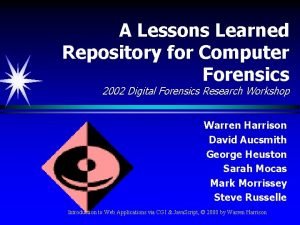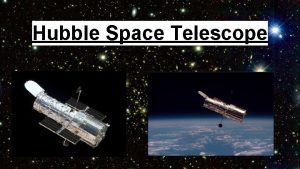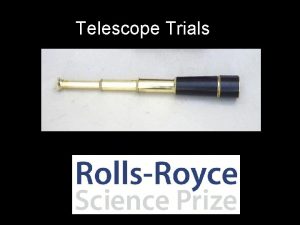The High Definition Space Telescope Lessons Learned Marc














- Slides: 14

The High Definition Space Telescope Lessons Learned Marc Postman Space Telescope Science Institute

Exo. Earth Yield Results (see Stark et al. 2014; 2015) ηEarth = 0. 05 Pessimistic IWA = 3λ/D ηEarth = 0. 2 Optimistic IWA = 3λ/D nexozodis= 3 5 10 50 100 A 12 -meter telescope can detect and study 20 - 70 Earth-like planets: this is enough to detect or significantly constrain the incidence of biomarker molecules.

HDST surveys a broad range of stars The distribution of stellar spectral types in the design reference mission (DRM) for a 12 m HDST (green) and for a 4 m exoplanet mission (blue). The histograms show the number of stars in each spectral type surveyed with a survey integration time of 1 year (which includes spectroscopic characterization of Earth-like planets). HDST surveys a total of 561 stars. The 4 m space telescope surveys 74 stars. The Stark et al. (2015) altruistic yield optimization algorithm is used in these DRMs.

How Do Galaxies Grow, Evolve, and Die? Epoch z = 1 - 8 Resolution 30 -100 pc WFIRST-HLS entire sky observed @ 1” resolution Euclid-Wide (J) LSST (Y) UKIDSS (K) HDSTSDSSIII (z) WFIRST-SN-Wide. Parallels HDST-FOV WISE (3μm) WFIRST-SN-Deep Euclid-Deep (J) HDST-FOV 70 hr @ V 1 hr @ V E-ELT MICADO (1 hr @ J) CANDELS-Wide (J) CANDELS-Deep (J) JWST NIRCAM HUDF (IR) number of spatial resolution elements in the observed field Dwarf Galaxy G Dwarf star at at z = 8 10 Mpc 32 34 Adapted from AURA Report by Kate Whitaker, U. Mass. Amherst

How Did the Milky Way Form from its Earliest Seeds? Epoch z = 1 - 8 Spatial Resolution 30 -100 pc Milky Way Progenitor at z = 2 JWST* (z, J, H) HST (V, I, H) 400 pc HDST (V, I, H) 250 pc 100 pc With unique 100 parsec resolution in the optical at all redshifts, HDST can resolve the building blocks of galaxies: individual star forming regions and dwarf satellites, including progenitors of the present-day dwarf spheroidals. These high-resolution images will complement spectroscopy from 30 m class groundbased telescopes and ALMA of the galaxies and their molecular gas. HDST will spatially resolve SFR, Hα/Hβ, BPT diagnostics, He. I/Hβ, etc. Images simulated by Greg Snyder (STSc. I)

UV Access is Essential! UV spectral features provide the some of the best, and often unique, constraints on: Ionization state of ISM, IGM Structure in ISM, IGM Sources of ionization Gas Temperature Metallicity of ISM, IGM Gas Density Star formation rate Gas kinematics and outflows High spectral resolution is often required to make such measurements (R > 20, 000)

The Gas - Galaxy Connection How do galaxies transition to quiescence? What are the dynamics of flows into and out of galaxies? How (and where) does the baryonic lifecycle evolve? HST+COS & stacking of multiple FOV: Simulated Milky Way galaxy at z = 0. 25 (Joung, Fernandez, Bryan, Putman and Corlies (2012, 2015) HDST + UV MOS for any single FOV: 200 kiloparsec Using powerful and unique multi-object UV spectroscopy, HDST will be able to map the “faintest light in the Universe” emitted from gas filaments entering galaxies and energetic feedback headed back out.

F 814 W How Does Star Formation History Create Volume Resolution the Diversity Shapes and Sizes of < 100 Mpc 1 - 10 pc Galaxies? HST JWST 8 m F 606 W-F 814 W 16 m Elliptical Spiral Dwarf With HDST one could observe ~10 QSOs behind all galaxies within ~10 Mpc (purple line) and >1 QSO behind every galaxy out to 30 Mpc. Gives gas halo characteristics in the SAME galaxies that you get complete SFHs. Star formation history sets both chemical evolution and planet formation rates. Visible bands provide best discrimination. Requires diffraction limited optical imaging and high PSF stability. Aperture Driver: > 10 m needed to resolve stellar pops down to 1 M⦿ out to the nearest giant ellipticals.

Visible and UV Sensitivity is Essential! Volume Resolution < 100 Mpc 1 - 10 pc JWST will observe the integrated populations of stars at high redshift but will not reconstruct their detailed star formation histories. ELTs will probe stellar pops in NIR and primarily study later phases of stellar evolution (stars not on the Main Sequence). Far UV Spectra of MSTO stars as a function of their age HDST will provide essential (highly agesensitive) data in UV/optical. HDST will also reach below the main sequence turn off (MSTO) for all stellar populations out to 10 Mpc. ELTs cannot do this!

10 m+ Aperture Drivers UV Sensitivity Drivers Characterize upwards of 30 -50 exo. Earth candidates. Obtain statistically significant constraint on eta-habitable and eta-life, even in presence of null result. Resolve all galaxies to 100 parsec or better, to individual SF regions. Identify stellar progenitors and host environments for diverse transients, key to unraveling causes. Reach > 100 s of background QSOs/AGN for outflow and IGM/CGM studies. Stringent and unique test of cosmological structure formation models. Resolve stellar pops down to 1 M⦿ out to the nearest ellipticals. Definitive understanding of the stellar IMF. Detect transverse motions of virtually any Milky Way star, Local Group satellites, and giant ellipticals in the Virgo cluster (~15 Mpc). New constraints on nature of Dark Matter. Examine protoplanetary disks at ~1 -3 AU resolution out to > 100 pc. Key constraints on planet formation. Resolve individual stars in young clusters everywhere in the MW and Magellanic Clouds. Galaxy - Gas connection at unprecedented spatial resolution. Detect UV emission from gas accreting into and ejected from galaxies. Detect hot plasma ejected by SMBHs acting as feedback on their galaxies. Use UV MOS/IFU to dissect multiphase gas feedback flows in nearby galaxies. Obtain disk abundances of C, N, O, Si, Fe (from UV lines) that strongly influence planet mass and composition. Measure protostellar accretion rates from UV continuum and lines out to MCs.

HDST in Context: Synergy with Other Facilities Spatial Resolutio n at z=2 85 kpc 8. 5 kpc Spatial Resolutio n at 1 Mpc 50 pc 5 pc 850 pc 1. 6 light years 85 pc 10, 300 AU

HDST Technologies Needed: Lightweight Optics Starshade, Formation Flying Thermal Control Scattered Light Mitigation Serviceable Instruments and Avionics Large Deployable Structures High Performance Coronagraph (10 -10 contrast) Active Wavefront Sensing & Control System Disturbance Isolation Milli-arcsecond Pointing Control

tra (U l ) te lo cto w r no ise De e ur ct St ru or s Starlight Suppression M irr e ad sh St ar y ilit Readiness Level 6 5 4 3 2 1 St ab ) C m oro en n te ag d ra Te ph le sc op e (S eg The Path Forward Telescope Technologies Other Tech 2024 2019? Current

As astonishing as it might be to find life on other worlds, we already know that the story of all life in the cosmos, regardless of how alien it may be, arises from galaxies, stars, and planets formed from heavy elements made in stars. Exo. Earths Cosmic Origins A worthy endeavor is to design a long-lived space observatory that can both enable revolutionary studies in astrophysics and allow us to embark on a serious search for life elsewhere in the Galaxy. Wide Community Ownership and Participation is Essential!
 High definition space telescope
High definition space telescope Lessons learned faa
Lessons learned faa Hyatt regency walkway collapse
Hyatt regency walkway collapse Change management lessons learned
Change management lessons learned Workday implementation lessons learned
Workday implementation lessons learned Contest at mt carmel
Contest at mt carmel Lessons learned from the tower of babel
Lessons learned from the tower of babel Lessons learned repository
Lessons learned repository Lessons learned suomeksi
Lessons learned suomeksi Lesson learned in typhoon yolanda
Lesson learned in typhoon yolanda Lessons learned ground rules
Lessons learned ground rules Lessons learned from ants
Lessons learned from ants Life of pi lesson learned
Life of pi lesson learned Tac lessons learned
Tac lessons learned Dps project title
Dps project title



























